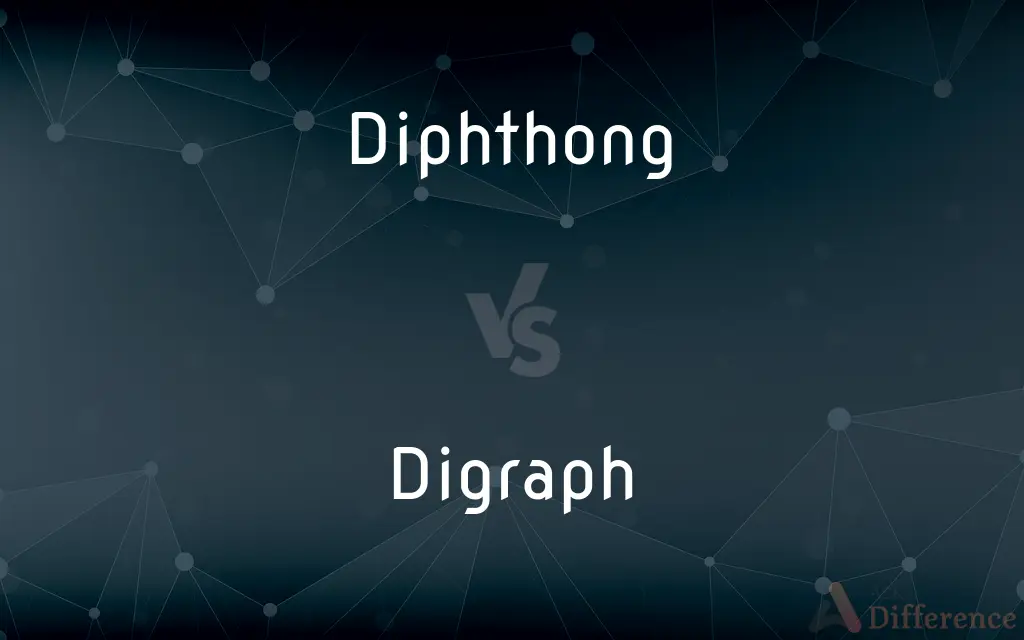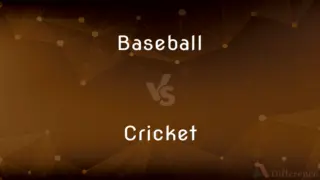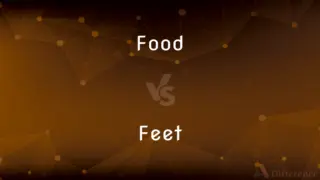Diphthong vs. Digraph — What's the Difference?
By Tayyaba Rehman — Updated on November 6, 2023
A diphthong is a complex vowel sound within a single syllable; a digraph is a pair of letters representing one sound.

Difference Between Diphthong and Digraph
Table of Contents
ADVERTISEMENT
Key Differences
A diphthong is a vocalic glide, a sound formed by the combination of two adjacent vowels within the same syllable. As the tongue moves from one vowel to another, it creates a distinct vowel sound that starts with one vowel and glides into another. A digraph, in contrast, is a combination of two letters that together represent a single sound, which may be a vowel or a consonant.
The concept of a diphthong is purely phonetic, meaning it is related to the sound produced when the diphthong is spoken. English examples include the "oi" in "coin" or the "ow" in "how". On the other hand, digraphs pertain to orthography or the way in which sounds are written. Examples of digraphs include "ch" as in "church" or "ea" as in "bread", which represent single sounds.
Diphthongs contribute to the rich variety of vowel sounds in English and other languages, often posing challenges for non-native speakers because of their gliding nature. Digraphs can also be tricky for learners, as the two letters do not always represent sounds that are intuitive based on the individual letters, such as the "ph" sounding like "f" in "phone".
Understanding diphthongs is critical for mastering pronunciation and fluency in a language because they influence vowel quality and syllable structure. Digraphs, while related to writing and reading, are essential for accurate spelling and sometimes can signal specific pronunciations, like the "gh" in "though" versus "tough".
While a diphthong involves the blending of sounds, it still counts as one phonetic unit, even though it contains two vowel sounds. Digraphs can represent a single phonetic unit as well, but they can also sometimes signal two separate sounds in different contexts, such as the "th" in "therapist" compared to "Thai".
ADVERTISEMENT
Comparison Chart
Definition
A blend of two vowel sounds in one syllable.
Two letters that represent one sound.
Function
Phonetic, affecting pronunciation.
Orthographic, affecting spelling.
Composition
Consists only of vowels.
Can be made up of vowels or consonants.
Variability
Sound changes within the syllable.
Represents a consistent sound.
Examples
"ai" in "mail", "oy" in "boy".
"sh" in "ship", "ch" in "cheese".
Phonological Role
Affects vowel quality and length.
Indicates specific pronunciation of consonants or vowels.
Compare with Definitions
Diphthong
A complex vowel sound that starts with one vowel and glides into another.
The word loud contains a diphthong.
Digraph
A pair of characters used in the spelling of a single phoneme.
Shoe starts with the digraph sh.
Diphthong
A sequence of two adjacent vowel sounds within the same syllable.
Coin includes a diphthong in its pronunciation.
Digraph
An alphabetic construct that can cause pronunciation confusion for learners.
Though and through contain the same digraph gh but it is silent in though.
Diphthong
A unit of sound important for linguistic analysis and phonetics.
Linguists study how the diphthong in cake is articulated.
Digraph
Two letters that come together to represent a single sound.
The digraph ch in cheese is pronounced as /tʃ/.
Diphthong
A vocalic transition within a single syllable.
Boil features the diphthong oi.
Digraph
A concept taught in reading to help with decoding.
Children learn that the digraph ea in bread has a short vowel sound.
Diphthong
A diphthong ( DIF-thong or DIP-thong; from Greek: δίφθογγος, diphthongos, literally "double sound" or "double tone"; from δίς "twice" and φθόγγος "sound"), also known as a gliding vowel, is a combination of two adjacent vowel sounds within the same syllable. Technically, a diphthong is a vowel with two different targets: that is, the tongue (and/or other parts of the speech apparatus) moves during the pronunciation of the vowel.
Digraph
A combination of two letters representing one sound, as in ph and ey.
Diphthong
A complex speech sound or glide that begins with one vowel and gradually changes to another vowel within the same syllable, as (oi) in boil or (ī) in fine.
Digraph
A pair of letters representing a single speech sound, such as the ph in pheasant or the ea in beat.
Diphthong
(phonetics) A complex vowel sound that begins with the sound of one vowel and ends with the sound of another vowel, in the same syllable.
Digraph
A single character consisting of two letters run together and representing a single sound, such as Old English æ.
Diphthong
(rare) A vowel digraph or ligature.
Digraph
(graph theory) A directed graph.
Diphthong
A coalition or union of two vowel sounds pronounced in one syllable; as, ou in out, oi in noise; - called a proper diphthong.
Digraph
(computing) A two-character sequence used to enter a single conceptual character.
Diphthong
To form or pronounce as a diphthong; diphthongize.
Digraph
(linguistics) A pair of letters, especially a pair representing a single phoneme.
Diphthong
A vowel sound that starts near the articulatory position for one vowel and moves toward the position for another
Digraph
Two signs or characters combined to express a single articulated sound; as ea in head, or th in bath.
Diphthong
The articulatory process where the tongue moves during the pronunciation of a vowel.
The pronunciation of ice demonstrates a clear diphthong.
Digraph
Two successive letters (especially two letters used to represent a single sound: `sh' in `shoe')
Digraph
A feature of alphabetic systems where two letters are associated with one sound.
The digraph ph in phone sounds like an f.
Common Curiosities
What is a digraph?
A digraph is two letters that represent one sound in the alphabet.
Do digraphs only represent vowel sounds?
No, they can represent vowel or consonant sounds.
Can a digraph be made of two consonants?
Yes, for example, "sh" in "ship".
Are diphthongs common in English?
Yes, diphthongs are frequently found in English words.
Can diphthongs change the meaning of words?
Yes, different diphthongs can give different meanings to words.
What is a diphthong?
A diphthong is a sound formed by combining two vowels in a single syllable.
Are all two-letter vowel combinations diphthongs?
No, only if they create a single gliding sound.
Is "kn" in "know" a digraph?
Yes, although the "k" is silent, it is a digraph.
Are digraphs used in all alphabetic languages?
Many, but not all, alphabetic languages use digraphs.
Can digraphs be silent?
Yes, sometimes one or both letters in a digraph can be silent.
Is "ai" in "rain" a diphthong?
Yes, it's a diphthong because it combines two vowel sounds.
Can digraphs be found at the beginning of words?
Yes, digraphs can be found at the beginning, middle, or end of words.
Do diphthongs involve a change in tongue position?
Yes, the tongue moves from one position to another.
Do diphthongs only occur in stressed syllables?
No, they can occur in both stressed and unstressed syllables.
Is there a difference between a diphthong and two adjacent vowels?
Yes, two adjacent vowels may not necessarily form a diphthong if they belong to separate syllables.
Share Your Discovery

Previous Comparison
Baseball vs. Cricket
Next Comparison
Food vs. FeetAuthor Spotlight
Written by
Tayyaba RehmanTayyaba Rehman is a distinguished writer, currently serving as a primary contributor to askdifference.com. As a researcher in semantics and etymology, Tayyaba's passion for the complexity of languages and their distinctions has found a perfect home on the platform. Tayyaba delves into the intricacies of language, distinguishing between commonly confused words and phrases, thereby providing clarity for readers worldwide.














































